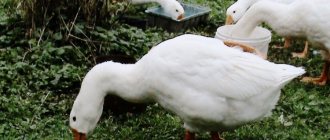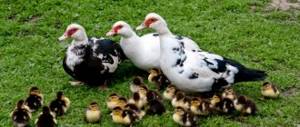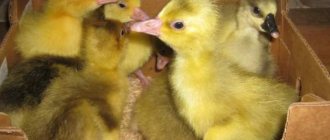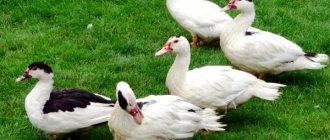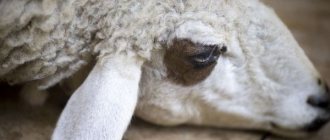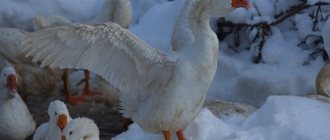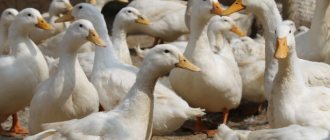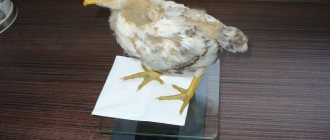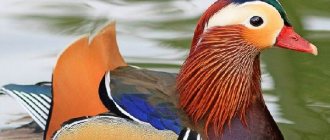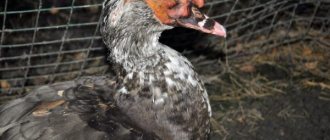Kholmogory geese
The breed is exclusively for economic purposes. The bird is not practical. It is bred only for decorative purposes, since due to the difficulty of breeding it is very expensive to maintain.
Kholmogory geese reach puberty at three years of age and live for about 17 years. In order for poultry breeding to be a profitable business, it is necessary to adhere to the rules of hygiene, since otherwise the birds may simply die.
The disadvantage of the breed is its low egg production - they produce 10-15 eggs per year. They also have a low offspring survival rate - up to 50%. Although these qualities are valued in an animal.
Large gray (Ukrainian) breed of geese
This bird species attracts with its unusual appearance. Geese fatten quickly, are unpretentious in care and food, have a large body, a calm character and good health.
Adult geese can gain weight up to 7 kg, sometimes up to 9 kg. Females can lay up to 60 eggs per year, egg hatchability is 70%. This is an excellent bird for fattening and for fatty liver.
Toulouse breed of geese
The animal has French roots. This bird is black in color, its weight reaches up to 12 kg, the goose weighs about 7 kg. Liver is also in demand; the weight of one product is up to 0.5 kg.
The goose is famous for its high growth rates, excellent weight gain, and unpretentiousness in nutrition. Toulouse breeds are valued for their rapid growth of fat reserves and the quality of their down.
The purpose of keeping this bird is to obtain meat, fluff, and liver for making pate. It is recommended to bake this bird with apples during the Christmas period. The disadvantage of Toulouse geese is their harsh living conditions. The temperature in the poultry house must be at least 20 degrees, and the room must be protected from drafts. It is important to maintain humidity.
Disadvantages of the breed: low egg production and offspring survival rate, sensitivity to temperature changes, drafts, high humidity, lack of maternal instinct.
Conditions of detention
If geese are bred for meat, then the best time to keep them is the summer months. This will save the owners from worrying about insulating the bird’s home.
To arrange a winter home for geese, you must first think about insulation. Geese do not tolerate drafts, so the structure must be built without cracks.
When choosing young animals, you need to pay attention to the qualities of the domestic goose breed. The bird should be vigorous, healthy with a strong constitution and thick plumage
To obtain goose eggs, it is important to maintain the air temperature in the room and increase the length of daylight hours using artificial lighting sources. If proper conditions are maintained, the bird will begin to lay eggs within 30-40 days
Italian white breed
This variety comes from sunny Italy. Birds are accustomed to warm climates, but they can adapt perfectly to any urban conditions. The birds attract attention with their blue eyes, snow-white plumage, and bright orange beak and paws.
It is distinguished by a long neck, wings and tail. This breed can be characterized by its harmonious build. Italian white bird of medium size. By 16 weeks, the goose gains weight up to 4 kg. During this period, you can send geese to slaughter. Adult birds can reach up to 6 kg. This breed is in demand for preparing smoked meat, since goose does not tend to accumulate excess fat.
It produces up to 50 eggs per year, but sometimes up to 90 can be collected, since the breed quickly reaches puberty and begins to lay eggs early. Eggs can be collected twice a year. Of all the eggs, about 90% of the chicks hatch, most of which will boast excellent health.
The breed is also in demand for preparing liver pate and collecting down and feathers. The negative aspects of birds of this breed include the complete absence of maternal instinct. It is unlikely that you will be able to raise this breed without an incubator.
Andean
This breed is native to the Andes highlands from Peru to Chile and Argentina; birds live at altitudes of 3000 m and above. The Andean goose prefers open areas with short grass and lives in swampy areas, mountain valleys, river plains, meadows and pastures. They spend most of the year at an altitude of more than 3 thousand meters, but sometimes they can descend lower after heavy snowfalls.
Andean geese spend their time primarily on the ground and rarely take to the air, mainly to avoid danger. If it is not possible to take off, they will save themselves in the water, but if there is no danger, they rarely enter it, since they swim slowly and poorly due to the structure of the body and tail.
The plumage of the head, neck and front of the body is white, the tail and back are painted black. The beak and paws are marked with a bright red tint. Females and males look almost the same, but females are somewhat smaller in size. The length of individuals is 70–80 cm, weight can range from 2.7 to 3.6 kg.
There are many types of wild geese, but we looked at the characteristics of the main ones. Geese mainly stay on land, although they like to settle close to water, they feed on plant foods, migrate to warm regions in winter, and during migration or mating games, most species make a typical goose cackle.
Leghart Danish
Animals are often bred for their down. In a year you can get up to 0.5 kg of fluff from one bird. Starting from the age of 12 months, the fluff is cut off, repeating the procedure every month and a half.
Legard is an affectionate and sensitive bird that needs warmth and good care. You can feed the bird the same diet throughout the year. As for the temperature regime, it can be the same.
Disadvantages of the breed: low egg production, minimal survival rate of offspring, the need to raise birds in an incubator.
Conservation status of the blue-winged goose.
The Blue-winged Goose is classified as Vulnerable and is believed to be rarer than previously thought. This bird species is threatened by habitat loss. Threats to the blue-winged goose and other flora and fauna species of the Ethiopian Highlands have ultimately increased as a result of the phenomenal growth of the local population in Ethiopia in recent years. Eighty percent of the population living in the highlands uses large areas for agriculture and livestock raising. It is therefore not surprising that the habitat was greatly affected and underwent catastrophic changes.
If you find an error, please select a piece of text and press Ctrl+Enter.
Governor's geese
This is a fresh breed, bred by crossing the Italian and Shadrinsky goose. An adult male reaches up to 4-5 kg of live weight, a geese - up to 3.5-4 kg. A laying hen produces up to 45 eggs per year. Governor's geese have good hatchability and survival rate - more than 95%. The breed has excellent egg production and high quality meat.
Slaughter of geese and processing of carcasses
Geese are killed externally, just like chickens. On the left side of the neck, at a distance of 18-20 mm below the earlobe, an incision is made with a knife into the facial branch of the artery and jugular vein without an injection into the cerebellum. The incision should not exceed 1.5-2 cm in length. The carcass is hung up and the blood is allowed to drain.
Feathers are plucked after scalding with hot water (85-90 °C). Old geese are immersed in water several times. After scalding, plucking begins.
When processing carcasses, feathers are first removed from the wings and tail, then from the chest, back and legs. Using a knife, remove all fluff and stumps. The carcass is then roasted over a fire.
- Author: admin
Rate this article:
- 5
- 4
- 3
- 2
- 1
(2 votes, average: 5 out of 5)
Share with your friends!
Chinese geese
A popular breed valued for its high egg production. One goose produces up to 100 eggs per year. In addition, Chinese geese are valued for their high quality meat. But it is not very profitable to breed geese for meat, since the weight of an adult male reaches only about 4-5 kg.
The disadvantages of the breed are considered to be a poorly developed maternal instinct, as well as aggressiveness during egg laying. It is important to closely monitor the livestock.
Reasons for the decline in blue-winged goose numbers.
For a long time it was believed that the number of blue-winged geese was threatened by bird hunting by the local population. However, recent reports have shown that locals are trapping and capturing the geese to sell to the country's growing Chinese population. At a site in the vicinity of the Gefersa Reservoir, 30 km west of Addis Ababa, previously large populations of blue-winged geese have now become sparse.
This species is under pressure from a rapidly growing human population, as well as drainage and degradation of wetlands and grasslands, which are subject to increased anthropogenic pressure.
Intensification of agriculture, drainage of wetlands, overgrazing and periodic droughts also pose possible threats to the species' habitat.
Blue-winged goose - endemic to Ethiopia
Conservation Actions for the Blue-winged Goose.
No specific measures are being taken to conserve the blue-winged goose. The main nesting sites of the blue-winged goose are located within the Bale National Park. The Ethiopian Wildlife and Flora Conservation Organization has been making efforts to preserve the region's species diversity, but conservation efforts have been ineffective due to famine, civil unrest, and military action. In the future, it is necessary to identify the main nesting sites of blue-winged geese, as well as other vital non-breeding areas, and create protection for threatened species.
Monitor individual sites regularly across the range to determine population trends. Conduct bird movement surveys using radio telemetry to explore additional bird habitat areas. Conduct information activities and control shooting.
Mamut
A breed brought from Denmark. It is profitable to breed poultry for the sake of meat; the weight of a male reaches more than 13 kg, of a female - up to 9 kg. The advantage of birds is their good egg production - about 50 eggs per year. Geese of this breed have good survival and vitality. Disadvantages of the breed: poorly developed maternal instinct, difficulty in coping with the lack of water.
Shadrinsky geese
It is difficult to call this bird not resistant to frost, but it is important to make floors in the poultry house that will remain warm and dry. The optimal temperature for this breed is 18 degrees. The peculiarity of the bird is that it is not picky about food. When breeding geese, the farmer focuses on obtaining meat, since their weight is about 6 kg. The meat of Shadrinsky geese is very tasty and healthy. Goose down is very hard and is not in great demand.
The liver of the Shadrinsky goose reaches 400 g, which is why the birds are highly valued among breeders.
What is a goose: a bird or an animal?
Of course, such a question may seem stupid to many now, because most are sure that geese are birds. Yes, of course it is, this is a separate genus of waterfowl from the duck family.
But if you look at the scientific classification, you will find the following information: Geese - belong to the animal kingdom, the chordate type and the bird class. So, whether they are animals or not, it depends on how you look.
Geese are common on almost all continents of the Earth (except Antarctica). They live on the shores of seas, rivers, lakes, in meadows or marshy areas. There are mountain views. Unlike swans and ducks, they spend much less time in water than on land. Today there are both wild and domestic species.
Tula bird
A breed with a low egg production rate, and the weight of geese reaches up to 6 kg. But Tula geese are valued for their fighting qualities. Animals are not difficult to breed, because they are able to withstand not only severe frosts, but also extreme heat. They can withstand all conditions, but you need to carefully monitor their nutrition - excess weight can cause a fighter to lose shape.
Kuban gray geese
This breed was developed by crossing Chinese and Gorky geese. Poultry is no longer valued for its meat, because a goose weighs around 5-6 kg, but for its egg production - a laying hen produces up to 90 eggs per year, from which about 85% of the offspring are hatched. The advantage of the breed is the high survival rate of chicks. The disadvantages of the breed are considered to be the lack of maternal instinct, reluctance to hatch eggs and raise chicks.
Habitats of the blue-winged goose.
Blue-winged geese are found only on high plateaus in the subtropical or tropical altitudinal zone, which begins at an altitude of 1500 meters and rises to 4570 meters. The isolation of such places and remoteness from human settlements has made it possible to preserve unique flora and fauna; many species of animals and plants in the mountains are not found anywhere else in the world. Blue-winged geese inhabit rivers, freshwater lakes, and reservoirs. During the breeding season, birds often nest in open Afro-Alpine swamps.
Blue-winged goose (Cyanochen cyanoptera)
Outside the nesting season, they live along the banks of mountain rivers and lakes with adjacent meadows with short grass. They are also found on the edges of mountain lakes, swamps, swamp lakes, and streams with abundant pastures. Birds rarely live in overgrown areas and do not risk swimming in deep water. In the central parts of the range, they most often appear at altitudes of 2000-3000 meters in areas with marshy black soil. At the northern and southern ends of the range, they spread at heights with a granite substrate, where the grass is coarser and longer.
Number of blue-winged goose.
The total number of blue-winged geese ranges from 5,000 to 15,000 individuals. However, it is believed that due to the loss of places suitable for breeding, a decline in numbers is occurring. Due to habitat loss, the number of mature individuals is actually lower and ranges from 3000-7000, with a maximum of 10500 rare birds.
Linda
Linda geese are valued for their rapid weight gain - up to 7-8 kg. Geese reach sexual maturity at 8 months. They have an average egg production rate - a laying hen can produce 45-80 eggs per year. Bird down is also considered valuable.
This is a good start for a new farmer. The Linda breed is good for its unpretentiousness in food and care, and its ability to quickly adapt to different weather conditions. With simple maintenance, 100% profitability can be achieved.
In order for geese to always feel good, it is necessary that there is always a lot of water in their drinking bowls. Due to the fact that birds prefer solitude, it is recommended to arrange secluded corners with darkening for them.
Depending on the purpose for which the poultry farmer decided to start breeding geese: to collect eggs or sell meat, you need to responsibly approach the task of choosing a breed of geese. But we must not forget that only with proper care can we obtain high-quality meat and large eggs for sale.
0
0
Copy link
Goose
Geese are also waterfowl that are similar in appearance to many species of wild geese, but tend to be smaller in size. They have a short beak, short legs, black color, and dark colors predominate in their plumage. Geese also do not produce the cackling sound typical of geese. Their cry is more reminiscent of a dog's bark, more abrupt and short. Among them there are also many types. We will consider the main and most common ones below.
Canadian
This is the most famous representative of this species of wild geese. It is also often called the North American goose, as it lives mainly in Canada and Alaska. Among these geese, about 12 subspecies are distinguished, since the size and plumage of birds largely depends on their habitat.
The main species inhabits areas from the Arctic to the northern United States, and is also found in Scandinavia and the UK. These birds have gray-brown plumage with a white breast, black neck and head. Their striking feature is a bright white spot on the cheeks and a white stripe on the tail.
Red-throated
These wild geese are small, but the brightest and most unusual in color. So, they have a red chest with a white border, bright spots on the cheeks, white spots near the beak, a black back and a black belly. This type of geese is also easy to distinguish by another external feature - they have a fairly thick neck and an unusual crest on the head. This is a rare species, lives in the tundra in Taimyr, and also winters in the southern zone of the Caspian region and in the western Black Sea region.
Black
Due to its small size, this type of geese looks more like a duck than a goose. They have short legs and a fairly long body. This is the smallest species among all geese. They also differ in the dark black color of their feathers. Only the back and wings have brown spots, and there is also a white stripe on the neck, as in the photo.
Black geese are quite rare birds and live in tundra zones. In particular, they nest in North America, coastal tundra zones of Eurasia and even beyond the Arctic Circle. The winter is spent on the shores of England and Denmark, in the North Sea.
White-cheeked
This species is very similar in appearance to the Canada goose, but is smaller in size, weighing only 2.5 kilograms. The color of the feathers is two-tone: black on top, white below. Gray stripes are visible on the sides, as well as white spots on the cheeks, for which the bird got its name. This goose lives in mountainous regions of Europe, preferably in tundra zones. It runs well and also has a fast, easy flight.
Hawaiian
The homeland of this breed of geese is Hawaii, where they still live mainly in the wild. However, in Europe this bird is often kept as a pet. Unlike other geese, the Hawaiian geese have underdeveloped membranes on their feet, so they swim little and live more on land. In 1950, the population of these birds was on the verge of extinction, but the efforts of ecologists prevented their complete disappearance. Today, the Hawaiian goose still remains a rare species. See the photo for her exterior.
